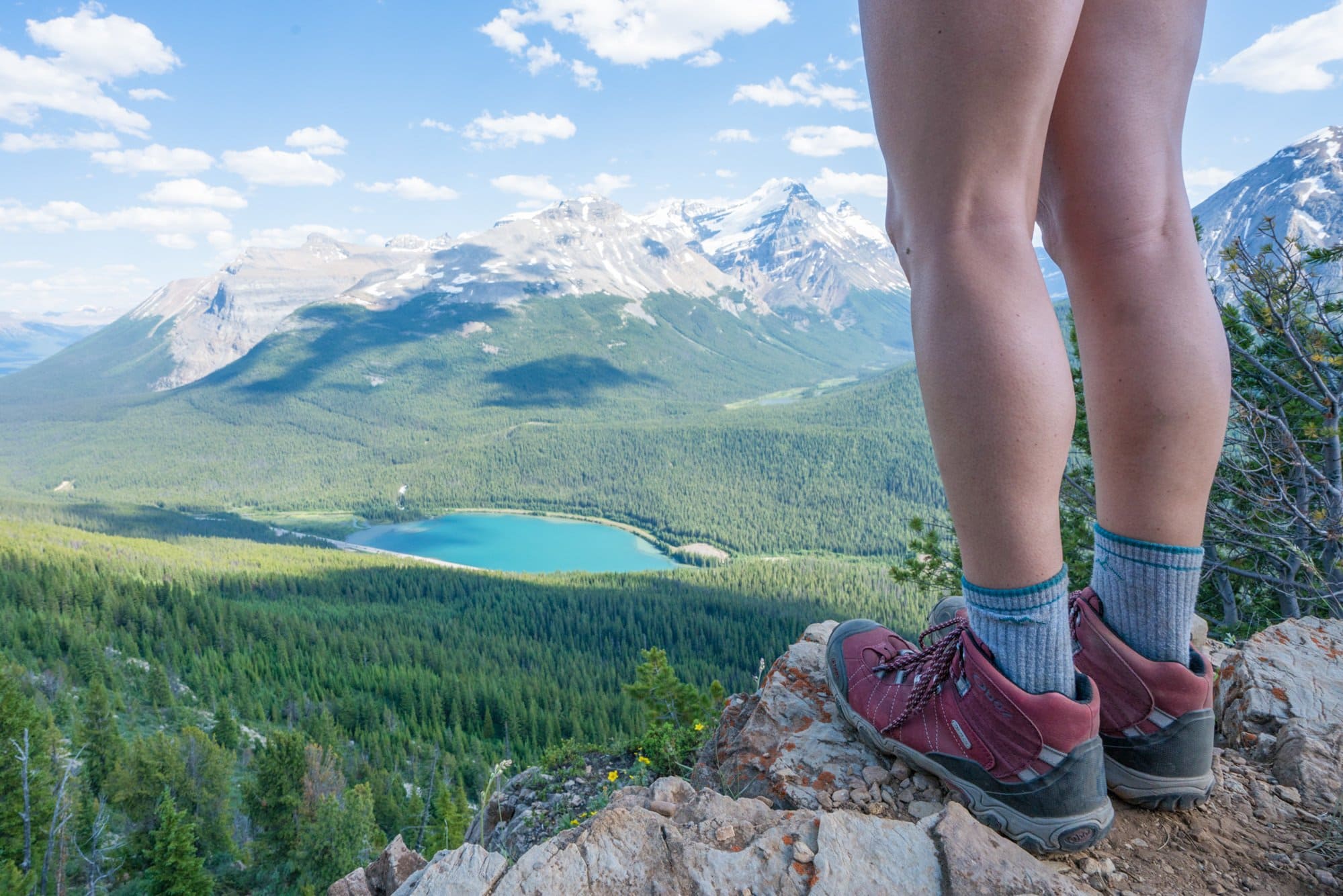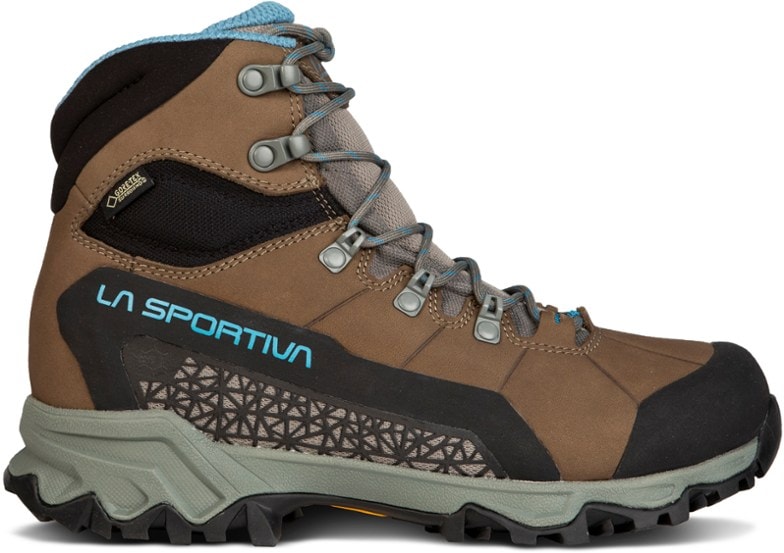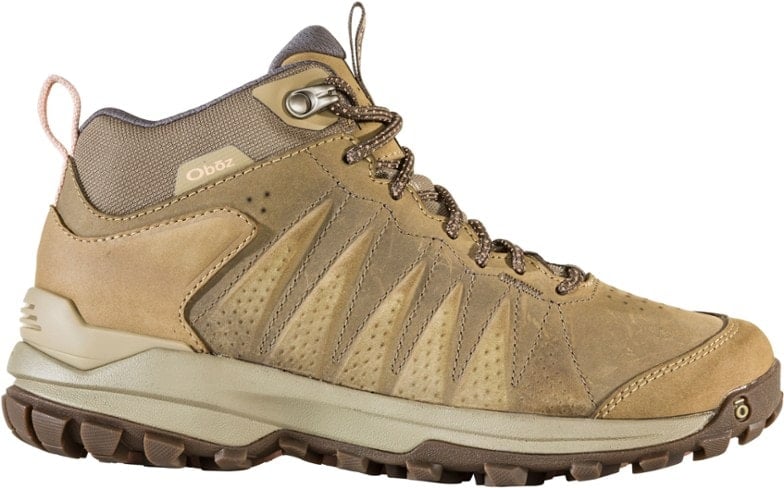Products You May Like
With hundreds of hiking boot options available, at some point, every hiker wonders about how to choose the best women’s hiking boots that will be the most comfortable for them. From leather to mesh, to ankle stability or that barely-there feel, the market is full of different styles of hiking shoes and boots that look like they can get the job done. So, how do you choose?
Here at Bearfoot Theory, we believe that the best women’s hiking shoes and boots are sturdy but not too stiff and will keep you comfortable and supported without weighing you down.
To help you find your sole mate (sorry, we had to!), here are our favorite women’s hiking boots in a variety of categories from full-on high ankle hiking boots to low ankle hiking shoes and lightweight trail runners. We also include the top factors to consider when buying a hiking boot that will hopefully last you lots of miles of wear and tear on the trail.
Note: Bearfoot Theory is an ambassador for Oboz Footwear, so you’ll notice several pairs of Oboz hiking boots on this list. We are huge fans of the brand and have tested out a variety of Oboz models over the years, but we’ve also included some other hiking boot brands for women who Oboz isn’t a good fit for.
Here are the best women’s hiking boots and shoes plus advice on how to choose the right ones for you.
Best Women’s Hiking Boots at a Glance
Best High Top Hiking Boots for Women
If you’re looking for a pair of sturdy hiking boots that are suitable for all kinds of terrain and provide maximum support, then high top hiking boots that fit over the ankle are a good choice.
This style will provide the most stability and the most ankle support on the trail. High top hiking boots also tend to be more durable and rigid than a low hiking shoe or a trail runner.
Go with a high-ankle hiking boot if:
- You’ll be hiking in variable conditions like muddy, steep or rocky terrain
- You’re going on a multi-day hike
- You’re carrying a heavy load on your back
- You want more support for your ankles and knees
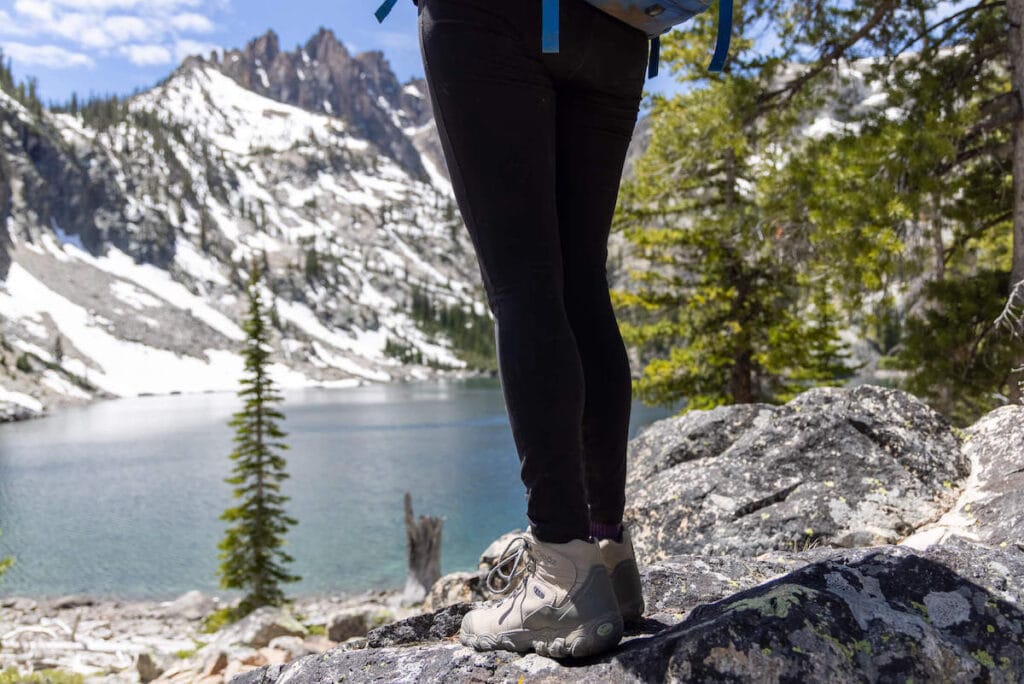
Here are the best higher-top hiking shoes for women.
Oboz Bridger Mid Waterproof Hiking Boots
Key Features
- Height: Over-the-ankle
- Waterproof: Yes
- Weight: 2 lbs, 0.4 oz (pair)
- MSRP: $180
Check Price: REI / Backcountry
Great For: Rocky Trails, Backpacking Trips, Hearty Day Hikes, Wet Climates
Pros: Supportive insole, excellent traction, very waterproof, ankle support, heel pocket that hugs, quick break in period, come in normal and wide options
Cons: Run slightly small
I have had a lot of foot issues in the past and I absolutely love Oboz women’s hiking boots because they don’t cause pain or discomfort on the trail. The Oboz Bridger Mid Waterproof Hiking Boots are my go-to for any adventure that requires something super sturdy and supportive.
I’ve worn these on a 10-day backpacking trip in Alaska and a 4-day backpacking trip in Olympic National Park. On both these trips we encountered non-stop rain, but my feet stayed completely dry, warm, and blister free. I’ve also worn them on a 5-day backpacking trip in Sequoia National Park where the terrain was very steep and rocky, and I carried a relatively heavy pack. I found them to have a sturdy sole, supportive insole, and great ankle support for a heavy load. The top hits about 1 inch above my ankle bone. They are moderately stiff which helps on uneven trails while still being comfortable.
I have relatively flat, narrow feet and these fit me perfectly. I really love how they back of the boot cups my heel so it doesn’t move on the up and downhill sections. If you have wider feet, they also come in a wide option. I suggest sizing up a 1/2 size to give your toes a little extra room in the toe box.
Additionally, Oboz plants a tree for every pair of shoes sold, which we love!

La Sportiva Nucleo High II GTX Hiking Boots
Key Features
- Height: Over-the-ankle
- Waterproof: Yes
- Weight: 1 lb, 9 oz (pair)
- MSRP: $209
Check Price: REI / Backcountry
Great For: Lightweight Backpacking Trips, Hearty Day Hikes
Pros: Lightweight yet supportive, comfortable right out of the box, grippy sole
Cons: Lack of cushion around ankle bones, low quality laces
Before I switched to Oboz I had the previous version of these boots.The La Sportiva Nucleo High II GTX Hiking Boots are an award-winning hiking boot for their comfort, durability, and support. These boots are on the lighter-weight side for a high-ankle hiking boot, making them a great option if you want stability without the weight. I found them to comfortable right out of the box with no break-in period. These are waterproof and offer excellent traction thanks to the Vibram sole.
The two issues I had with these boots is that my (very skinny) heel slipped out the heel pocket on the inclines. Second, the rim of the boot doesn’t have much cushioning, and it dug into my ankle when I flexed. With the new model, people also complain about the shoe laces being poor quality.
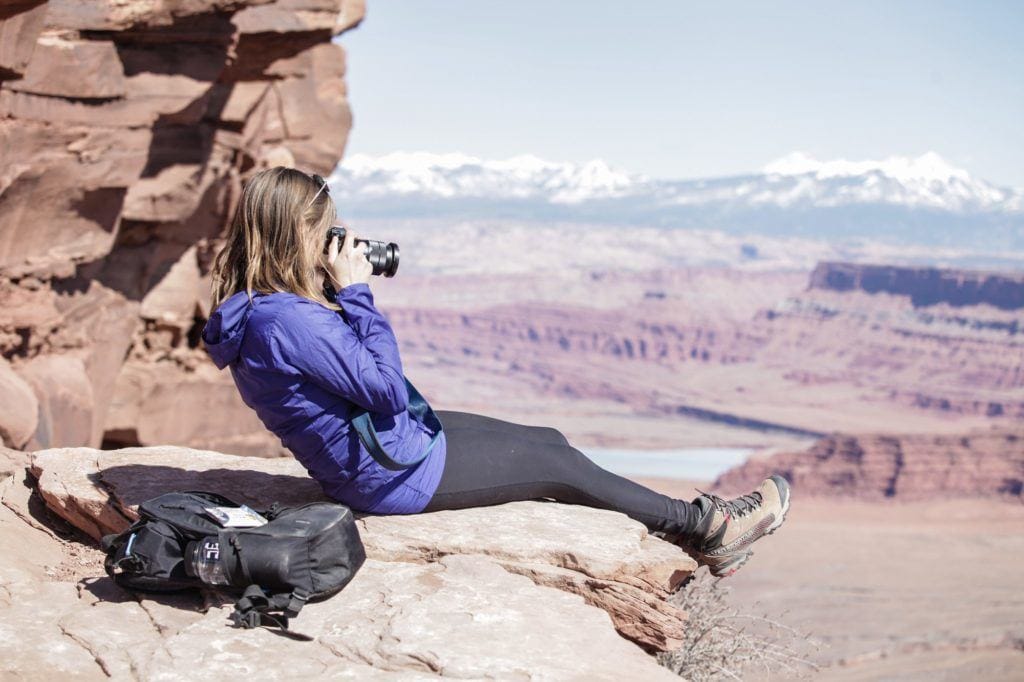
Zamberlan Vioz Lux GTX RR Hiking Boots
Key Features
- Height: Over-the-ankle
- Waterproof: Yes
- Weight: 3 lbs 7.5 oz (pair)
- MSRP: $350
Check price: REI / Backcountry
Great For: Big Backpacking Trips, Extra Rocky Terrain, Off Trail Traversing, Wet Climates
Pros: Handcrafted, comfortable right out of the box, supportive in all kinds of terrain
Cons: Very expensive, heavy
The Zamberlan Vioz Lux GTX RR Hiking Boots are the most pricey boot on this list, but they are very well made and will last a long time. They feature a waterproof leather upper and provide excellent support around the ankles for long backpacking trips. The Vibram soles are grippy and will give you confidence on a wide variety of terrain.
If you’re looking for a 4-season hiking and backpacking boot that is comfortable, durable, stylish, and will last you many seasons, these are a great option.
Best Mid-Ankle Hiking Boots for Women
Mid-ankle hiking boots still provide great ankle support but aren’t quite as high and offer a bit more flexibility and nimbleness on the trail. They’re a great choice for hikers doing both longer day hikes and overnight trips with a heavy pack.
Go with a mid-ankle hiking boot if:
- You need ankle support, but also want a lighter and more flexible hiking boot
- You want to move quickly through rugged terrain
- You will be doing longer day hikes or multi-day hikes with a backpacking pack
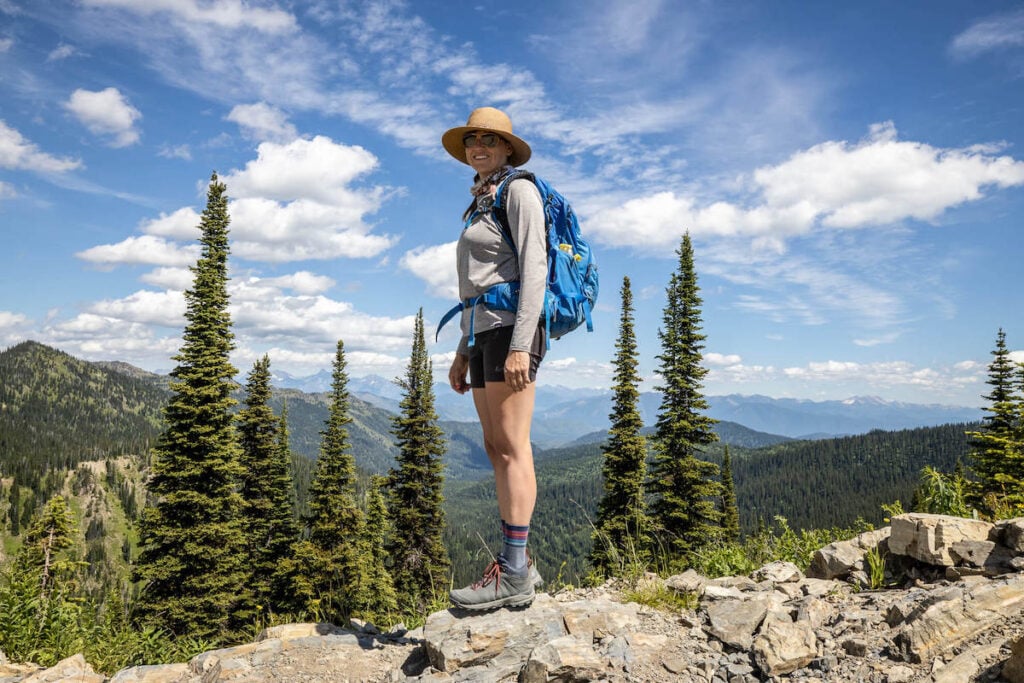
Here are the best mid-top hiking shoes for women.
Oboz Sypes Mid Hiking Boots
Key Features
- Height: Mid-ankle
- Waterproof: Yes
- Weight: 1 lbs, 11.6 oz (pair)
- MSRP: $165
Check Price: REI
Great for: All but the rockiest of terrain, hearty and light day hikes, backpacking trips, wet climates
Pros: Made with recycled and eco-friendly materials, comfy right out of the box, lightweight and flexible, comes in a wide version
Cons: Not as durable as the Oboz Bridger Mid boots
Offering the same supportive insole as the Oboz Bridger Mid boots above, the Oboz Sypes Mid hiking boots are a much lighter and more flexible hiking boot than the Bridger. These are currently my favorite boot for everyday hikes and best of all, they’re comfortable right out of the box with no break-in needed.
Despite being a bit softer than the some of the beefier hiking boots on this list, the Sypes provide superior grip, great ankle support without being too stiff, and the heel cups keep your foot in place. The boot literally fits my foot like a glove. There is no weird rubbing or hot spots, and my toes don’t jam into the front of the boot when i’m hiking downhill. I’m also able to pull the laces tight enough so my ankle feels really secure.
This model is the first in Oboz’s lineup to incorporate sustainable materials. Just like all of their shoes, Oboz also plants a tree for every pair sold.
My only complaint about the Sypes is the material on the toe area scuffs pretty easily, so they didn’t stay looking new for very long. While these come in some fun colors (I have the Slate), I’d probably get the Peppercorn next time. The darker Slate ends up looking pretty dusty after a day out on the trail.
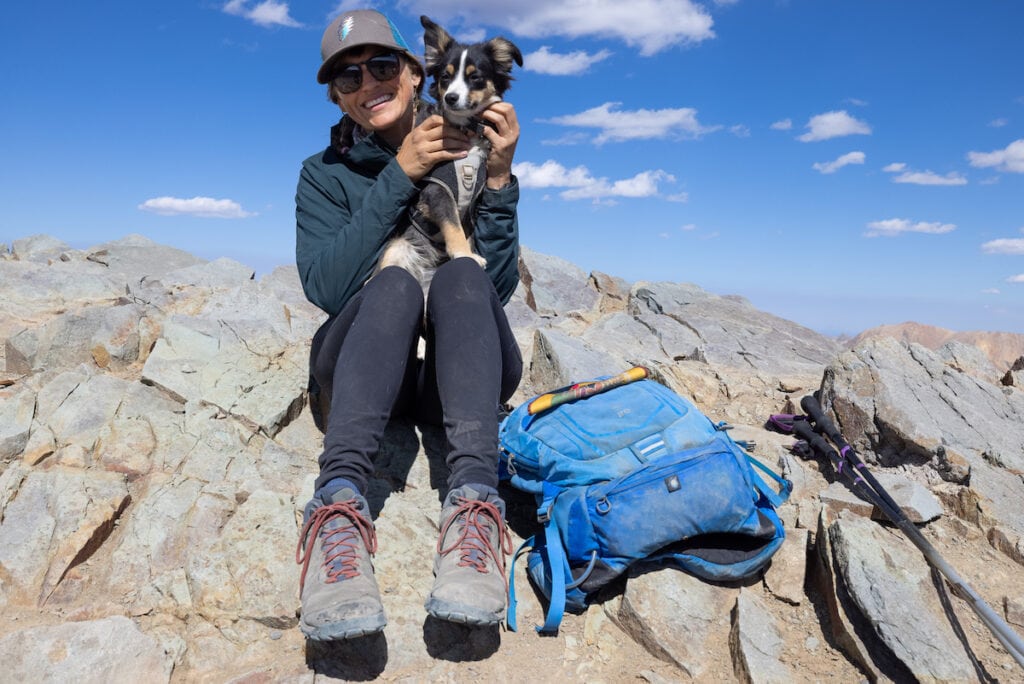
Merrell Moab 2 Mid Hiking Boots
Key Features
- Height: Mid-ankle
- Waterproof: Waterproof and Non-waterproof available
- Weight: 2 lbs (pair)
- MSRP: $135
Check Price: REI / Backcountry / Moosejaw
Great for: everyday hiking, drier climates, well packed trails, people with high arches
Pros: come in a wide version, no break in period required, budget friendly
Cons: not as waterproof as other boots on this list
The Merrell Moab 2 Mid Hiking Boots are a great budget-friendly option and are a very popular choice among women hikers. They come in both normal and wide versions, making them a great choice for women who have wider feet. These boots come to mid-ankle, so they still provide decent ankle support. The toe box on the normal width is a bit narrow, so consider sizing up a half size.
Some reviewers complain that these boots leak when wet even though they are advertised as waterproof. These also come in a non-waterproof version. Not sure if you need a waterproof boot? Check out our post on Waterproof vs Non-Waterproof boots.
Merrell MQM Flex 2 Mid GORE-TEX
Great for: Day hiking, drier climates, going quick, vegans
Key Features
- Height: Mid-ankle
- Waterproof: Yes
- Weight: 1 lb 7 oz (pair)
- MSRP: $160
Check price: REI
Pros: vegan-friendly, lightweight, come in fun colors
Cons: not as waterproof as other boots on this list, stiff at first and requires some break-in time, not a ton of arch support
The Merrell MQM Flex 2 Mid is the perfect lightweight shoe for anyone looking for a vegan-friendly hiking boot. This boot combines all the best features of a trail runner and a hiker into one and offers mid-ankle support.
BFT’s content coordinator, Courtney, tested these boots on day hikes and backpacking trips throughout California, Washington, and Arizona and found that they were great for hiking in rocky, uneven terrain due to the grip of the mountain-grade rubber outsoles, and the mid-ankle height provided enough support to feel secure while still allowing for full range of motion. However, the MQM Flex 2 didn’t hold up as well in wet conditions. On a rainy hike in Olympic National Park, water seeped in through the shoelace eyelets and she ended up with wet socks.
These boots are a little stiff at first so give them some time to break in. Courtney has a high arch, and after a few trial runs in these boots, she ended up adding insoles to provide more arch support. These are her go-to hiking boots for dry climates and rocky terrain, but she’d leave these at home for rainy, wet hikes. You can find the low-ankle version of this boot here.
Best Low Top Hiking Boots for Women
Low top hiking boots tend to be lighter and more flexible than both high-ankle and mid-ankle hiking boots. However, they don’t provide the same ankle support. Low hiking shoe options tend to be a good choice for day hikes and well-worn trails when you aren’t carrying a heavy load or tackling lots of rocks and roots. Experienced female hikers might also choose these on rocky trails so they can be lighter and quicker on their toes.
Go with a low hiking shoe if:
- You’ll be using them for day hikes
- You’ll be carrying only a light load on your back
- You’ll be on well-worn and flat trails with a well-defined surface
- You do not need ankle or knee support

Here are the best low-top hiking shoes for women.
Oboz Sawtooth II Low Hiking Shoes
Key Features
- Height: Ankle
- Waterproof: Waterproof and Non-waterproof available
- Weight: 1 lb, 12.4 oz (pair)
- MSRP: $140
Check Price: REI / Backcountry / Moosejaw
Great for: All day hiking terrain, easy backpacking trips, wet climates
Pros: lightweight yet sturdy, come in regular and wide options, Oboz plants a tree for every pair sold
Cons: None that we’ve found so far
The Oboz Sawtooth’s have been my low top hiking shoe of choice for years. They are sturdy and waterproof with a grippy bottom that gives you plenty of traction for hikes in all types of conditions and trails. Another cool feature of these shoes is that they have an asymmetric collar around the ankle to accommodate unique ankle bone positions, which I find helps prevent chafing and rubbing. I’ve hiked steep Colorado 14ers, backpacked the Trans-Catalina Trail, and done a ton of easier day hikes in these. I also like wearing these around camp on chillier nights. I honestly don’t have any negative to say about the Sawtooths.
These also come in a non-waterproof version and a mid-ankle version which is very popular.
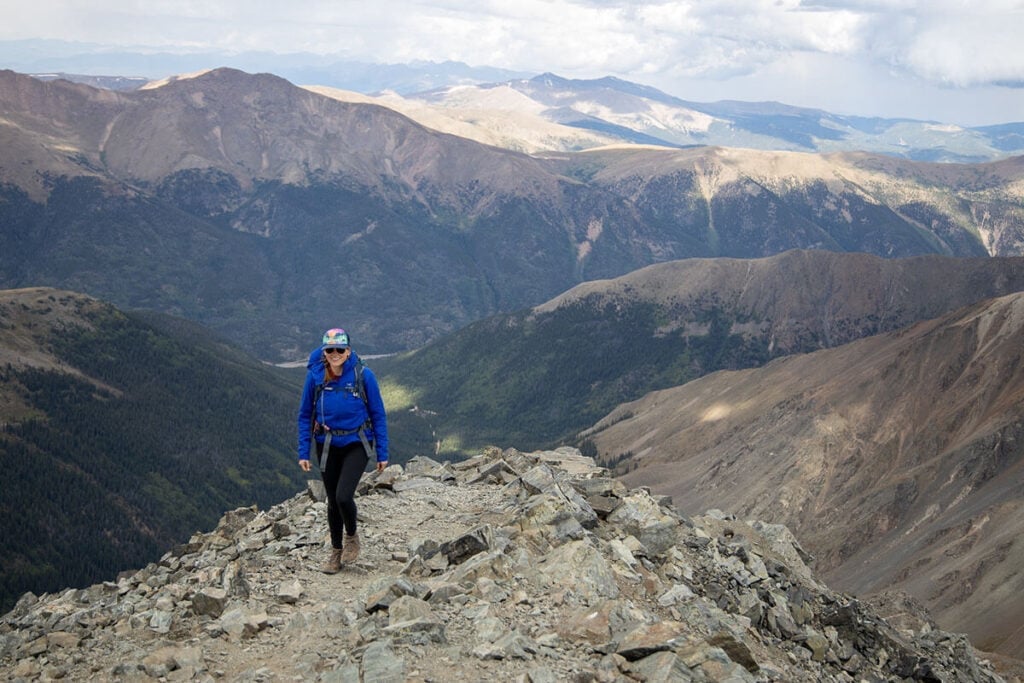
Keen Targhee III
Key Features
- Height: Ankle
- Waterproof: Yes
- Weight: 1 lb 9.2 oz
- MSRP: $164.95
Check price: REI / Backcountry / Keen
Great for: Women with wider feet, day hiking in hot or wet climates
Pros: wide toe box, durable and built to last, thick toe gaurd
Cons: insole is a little stiff
Keen’s are a popular choice for women who need a wider toe box. Their low-cut Targhee III hiking boot has been around for a long time, and for good reason. It has a loyal following that to its durability, comfort, and ability to tackle all types of terrain.
The flexible upper is breathable while still being waterproof and the Targhee III features Keen’s iconic rubber toe protection to keep your feet protected on even the roughest of trails.
These women’s hiking boots have great arch support, but may feel a little stiff right out of the box. After a few break in hikes, they should be comfortable.
Best Lightweight Hiking Shoes for Women
Imagine a shoe that’s somewhere in between a classic low-top hiking shoe and a trail runner. That’s where these lightweight hikers come in. They’re lighter and more flexible than the best women’s hiking boots and low-ankle hiking shoes on this list but are a little more rugged and durable than trail runners. They generally have mesh uppers rather than heavy-duty leather with more flexibility for movement compared to the firmness of other hiking shoes.
Go with a lightweight hiking shoe if:
- You want something lightweight and flexible
- You want something more durable than a trail running shoe
- You don’t need or want ankle support

Oboz Arete Low Hiking Shoes
Key Features
- Height: Ankle
- Waterproof: Waterproof and Non-waterproof available
- Weight: 1 lb, 1.6 oz (pair)
- MSRP: $125
Check Price: REI / Backcountry
Great for: vegans, everyday wear, light day hikes, camping trips, van life, neighborhood walks
Pros: Lightweight and verstaile, flexible, roomy toe box, came in a waterproof and non-waterproof version, fast on a variety of terrain
Cons: Less support than more sturdy hiking boots
The Oboz Arete Low Hiking Shoes have become my favorite lightweight hiking shoes for day hikes, camping trips, walks around the neighborhood, and everyday outings. They come everywhere with me. They’re comfortable right out of the box and are lightweight and breathable.
For how light they are, I’ve been surprised by their durability. I’ve owned the same pair for two years and worn them hundreds of days, and the sole is just starting to wear. When hiking, I’ve found the sole to be durable enough for rocky trails with plenty of traction. I have the non-waterproof version, which is great for warm desert hikes. If you hike is wetter climates, these also come in a waterproof version. These are a great choice for vegans as they aren’t made with any products that come from animals. For more on these, read my full review of the Oboz Arete.
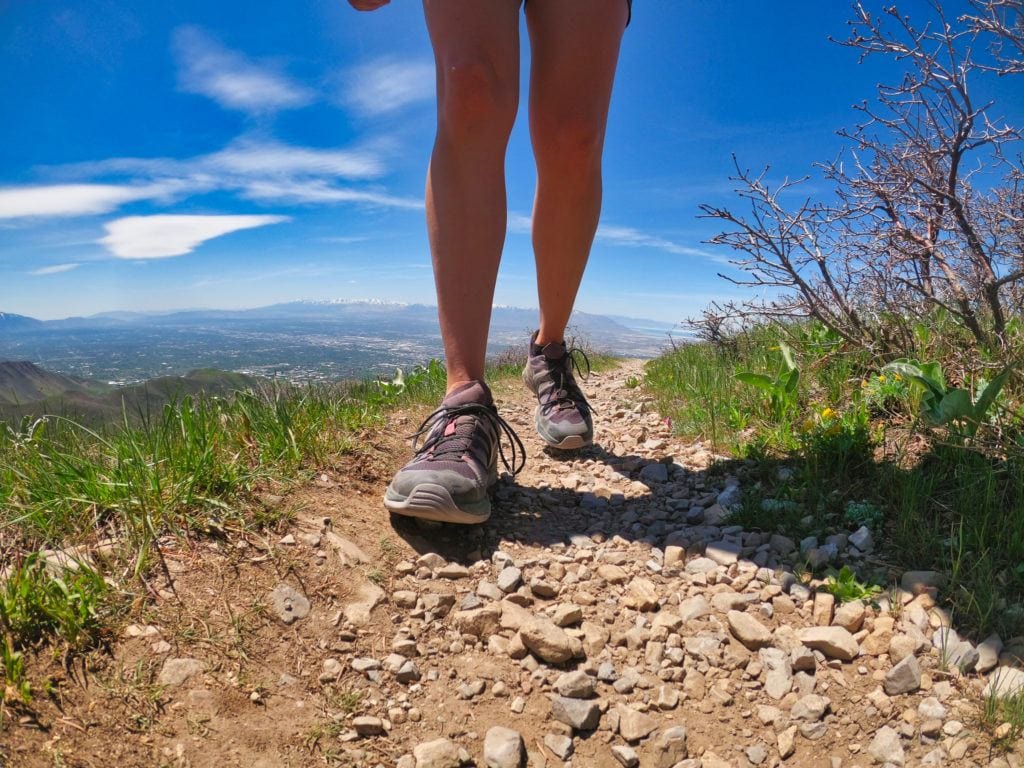
Salomon OUTline Low GTX Hiking Shoes
Key features
- Height: Ankle
- Waterproof: Yes
- Weight: 1 lb, 5 oz (pair)
- MSRP: $130
Check Price: REI / Backcountry
Great for: everyday wear, quick and light hiking, narrow feet
Pros: protective toe gaurd, large lugs on sole allows for great traction, comfortable right out fo the box
Cons: may not work for women with wide feet, not as waterproof as other boots on this list
The Salomon OUTline Low GTX Hiking Shoes are another great lightweight option that’s flexible yet rugged. These hiking shoes allow you to be agile on the trail while still providing protection against stubbed toes, stream crossings, and other trail obstacles. These are on the narrow end of the spectrum, and we recommend that you size up a half size in these.
Best Trail Runners for Hiking
Some folks will make the argument that trail running shoes are just as good an option for hiking. Since they’re so lightweight, many thru-hikers, like those on the John Muir Trail & Pacific Crest Trail, choose to hike in trail runners.
They aren’t for everyone, though, as some feel that they need more ankle support when carrying a heavy backpack. Also, trail runners won’t last as long as durable hiking boots or shoes so you’ll need to replace them more often when they wear out to protect your feet from injury.
Trail runners are good if:
- You’ll be hiking in very hot weather
- You want very lightweight shoes
- You want versatile shoes
- You don’t mind having to replace them more often
- You don’t need ankle support
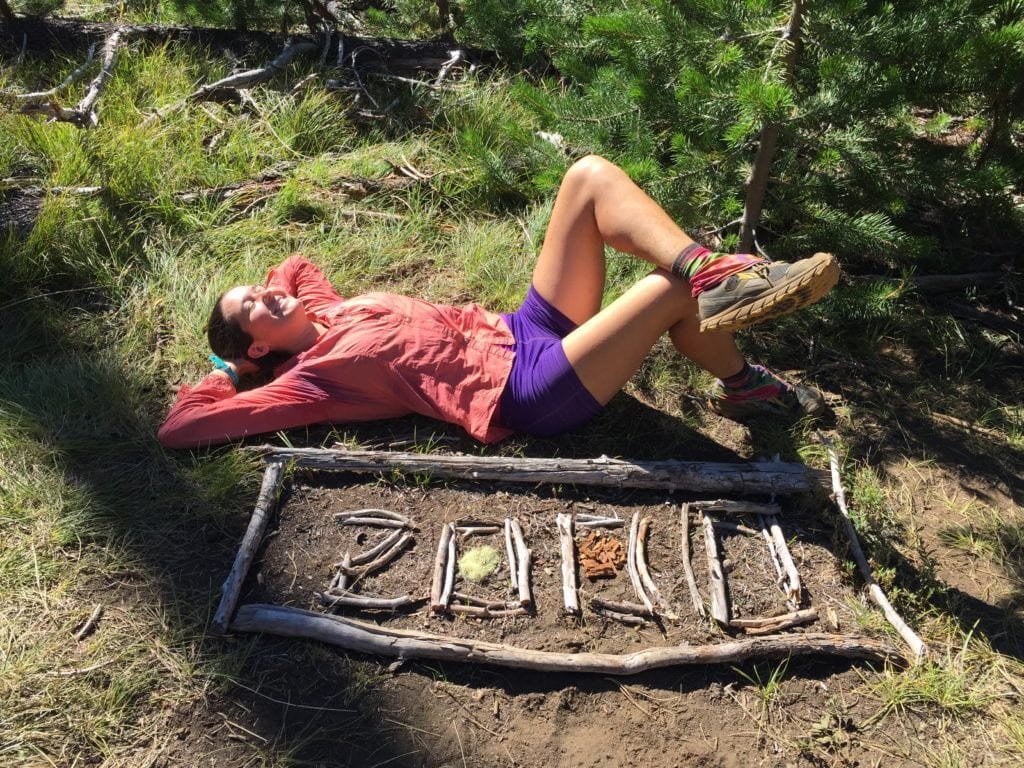
Here are the best women’s trail runners for hiking.
Altra Lone Peak 6
Key Features
- Height: Low Ankle
- Waterproof: No
- Weight: 1 lb, 1.4 oz (pair)
- MSRP: $140
Check Price: REI / Backcountry / Moosejaw
Great for: Light and fast hikers, day hiking, experienced thru-hikers
Pros: ultra light, they can attach to gaiters, wide toe box, come in regular and wide options
Cons: no waterproof version
We know more than a few thru-hikers who swear by the Altra Lone Peak trail runners as their go-to women’s hiking shoe. Altra is known for having a wide toe box to provide plenty of room for your toes to move. They also have gaiter tabs to secure gaiters should you choose to use them to help keep dirt and debris out on the trail. These are “zero-drop” which means your foot and heel are the same distance above the ground. This keeps your foot in its natural position.
Brooks Cascadia GTX Trail Running Shoes
Key Features
- Height: Low Ankle
- Waterproof: Waterproof and Non-waterproof available
- Weight: 1 lb, 2.8 oz (pair)
- MSRP: $160
Check Price: REI
Great for: everyday wear, trail running, smooth trails
Pros: Gaiter tab on heel, waterproof and non-waterproof options, vegan friendly
Cons: May not work for narrower feet
The Brooks Cascadia GTX Trail Runners are another favorite of many a thru-hiker and are more traditional (not zero drop). These are waterproof so if you get caught in the rain you’ll be able to keep your feet dry. These trail runners have gaiter tabs as well, and the outsoles are designed to provide traction in both wet and dry conditions. They come in a non-waterproof style if you don’t need the extra protection.
How to Choose Hiking Boots
How to choose the best hiking boots (or shoes) depends largely upon what kind of hike you’ll be taking. The climate and terrain, length of the hike, how much you’re carrying, and what activities you’ll be doing are all factors in determining what sorts of hiking boots or shoes to buy.
To help you make the best decision, here are a few basics to consider before you choose hiking boots.
Length & Terrain of the Hike
The length of your hike matters when it comes to footwear. So does the type of terrain you’ll encounter out there. A multi-day backpacking trip will require sturdier boots with better tread and ankle support than an easy to moderate trail on flat ground would need. I tend to wear high-top hiking boots on backpacking trips and low-top hiking shoes or lightweight hikers on day hikes.
Weather & Climate
The weather conditions and climate of the area will play a large factor in determining what kind of hiking boots or shoes to wear. If it’s cold and rainy or you’ll be trekking through streams and snow, waterproof boots are a must to not only keep your feet dry but also warm. Typically, we recommend a Gortex-type boot or shoe for most mountain hiking. On the other hand, mesh paneling and ventilation are better for when you are hiking in hot and humid climates like in the desert, Hawaii, or Central America.
Activities You’ll Be Doing on Your Hike
Different types of boots and shoes are suitable for different types of activities. The high-top hiking boots listed above will have high ankle support and more rigid soles that don’t allow for as much flexibility in order to help you stay steady when carrying a heavy pack. Others, like low-top hiking shoes, lightweight hikers, and trail running shoes will provide less ankle stability on rocky terrain but allow for more movement.
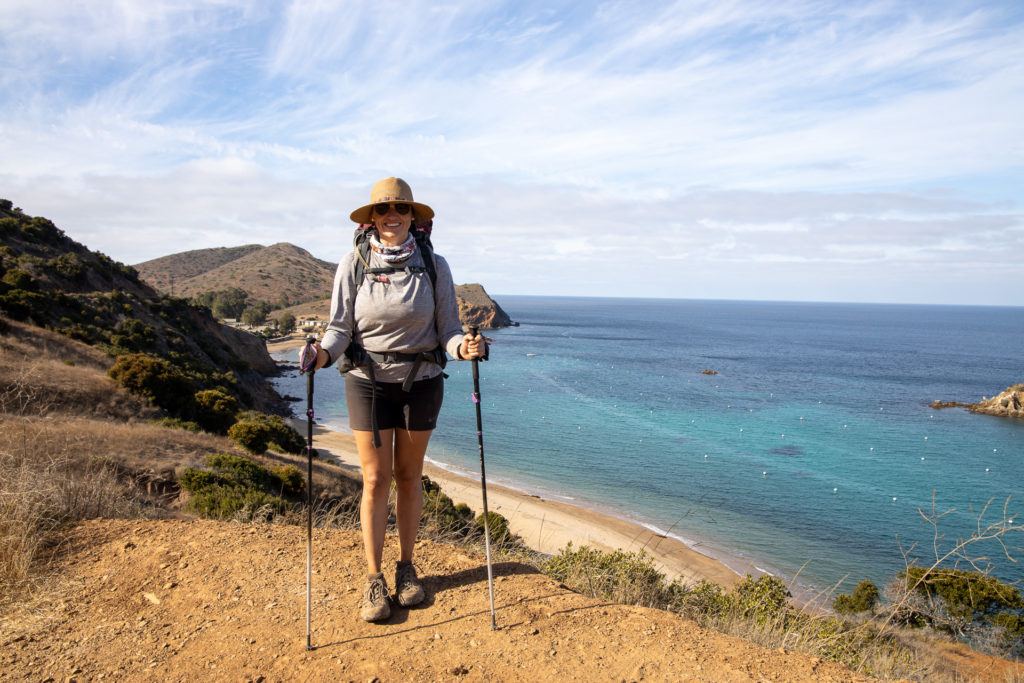
Hiking Boot Sole
Every hiking boot has a sole — three of them to be exact: an insole, midsole, and outsole. Each of these three soles help to support your foot while walking, and you can find a variety of options depending on what activity you are doing.
Insoles
The insole of a shoe is that soft and cushioned portion that you feel right beneath your foot when you slide your shoe on. It can be removed and replaced with one that better suits the shape of your foot, so, make sure you know how much arch support (if any) you need and what kind of insole supports your foot best.
Collapsed arches or an arch that’s too high doesn’t help evenly distribute the weight while walking and can cause wear and tear on your feet, ankles, knees, and hips. While you’re out on the trail for days at a time carrying a heavy pack, this is not a good problem to have, so make sure you do your research beforehand and even try on some different insoles in the store if you need more or less support.
Midsoles
The midsole is the second layer of cushion placed in between the insole and outsole to help absorb the shock of walking on hard and rocky surfaces. Most times the midsole is attached to a piece called the shank that provides extra sturdiness and is often made out of composite or steel. You won’t find this in very light and flexible trail shoes, but you will definitely find it in a hiking boot.
Outsoles
The outsole is the thick, rubbery outer portion on the very bottom of your shoe or boot. Most hiking boots have dense outsoles with treads (also called lugs) that make for good all-terrain footwear thanks to the traction and grip they provide on granular or slippery surfaces.
You’ll want to have bigger treads for better traction – like Vibram, a patented form of treads that are found on a lot of brand-name hiking boots. A hearty tread is important for multi-day backpacking adventures and trails with hard-to-walk on or slippery surfaces.
Break-In Period
A high-top hiking boot is generally constructed from heavier and sturdier materials than low-top, lighter-weight hiking shoes. Whether they are made of all leather or are a mix of leather, mesh, and suede, they are more durable, can withstand wear and tear, and are built to last longer. For this reason, the heartier the hiking boot the more time it will take to get broken in and mold to your foot.
You’ll want to break the most heavy-duty hiking boots in gradually to prevent painful blisters as they can be a little stiff at first. If you’re breaking in all leather boots, start by taking short walks around the house, the block, and eventually on short hikes about a week or two before you wear them out on the trail to soften the material. If your boot has a mixed material construction, they will be more flexible to begin with and break-in should only require a couple of short walks. And nowadays, some hiking boots don’t have a break-in period at all and are comfortable out of the box.
However, you never want the first time you wear a hiking boot to be the first day of your multi-day backpacking trip. Even if the hiking boots or shoes you purchase don’t have a break-in period, it’s important to try them out beforehand so you can work out any kinks and make sure they’re comfortable before taking them out on a multi-day trip.
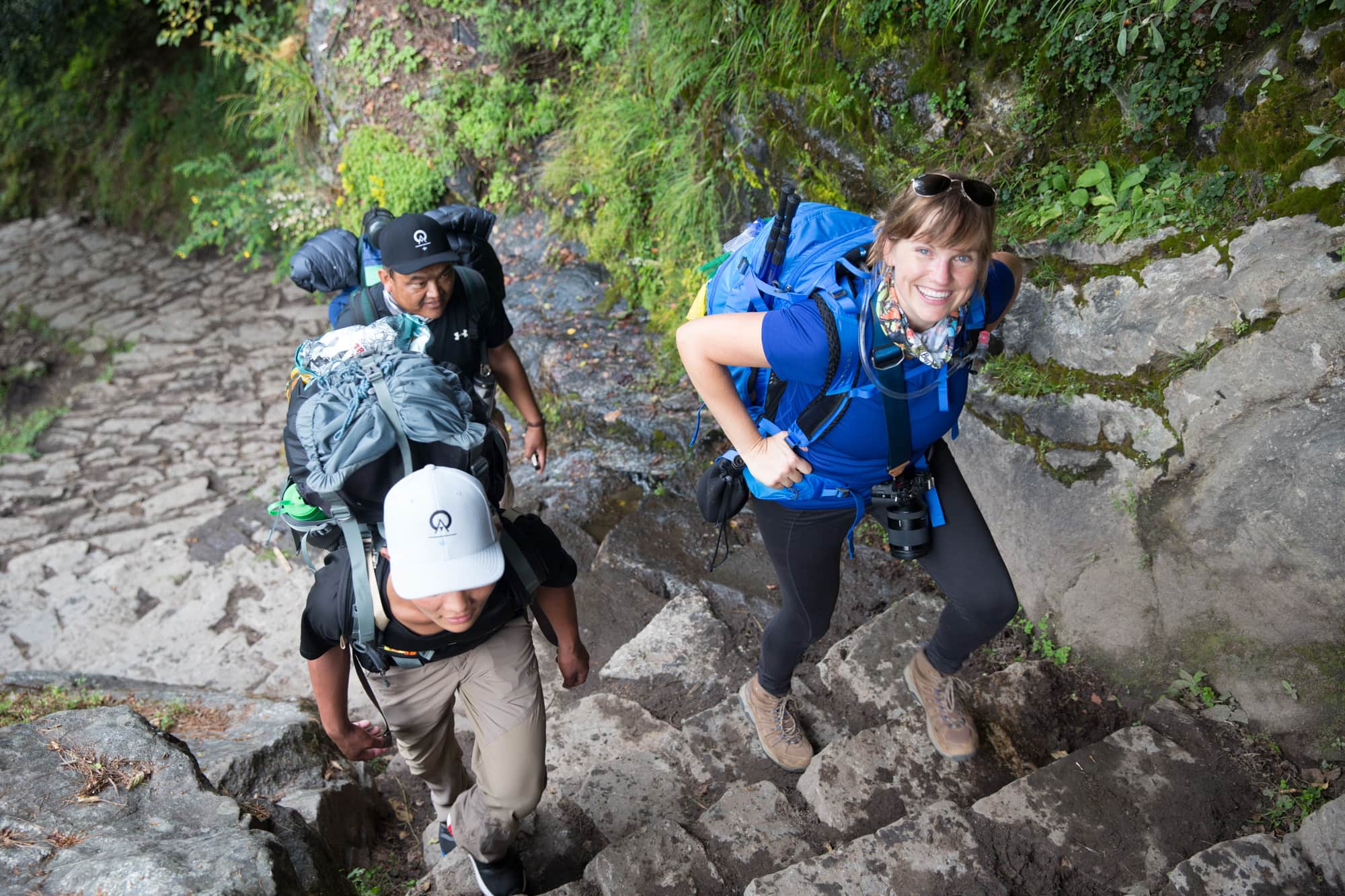
How Should Hiking Boots Fit?
Having the right fit and feel is of course one of the biggest parts of how to choose the best women’s hiking shoes or boots for your foot. There are a few key factors to be aware of when you are trying on hiking boots and shoes:
- As a good rule of thumb, always try your shoe on at the end of the day when your foot is the largest and slightly swollen
- If you wear insoles, make sure to bring them along when you try on boots in-store
- Bring your favorite pair of hiking socks along to try on with the boots or shoes you’re shopping for
- You should have enough space in the toe box to slightly wiggle your toes
- You want the shoe snug enough that your heel won’t lift up when hiking up and downhill, but you also don’t want your foot to feel squeezed
- You should be able to slide a finger inside of the shoe behind your heel to make sure you have enough space for your foot to move around and to account for swelling
Also, make sure you wear wool socks that are breathable and durable enough to protect your feet and keep you comfy. A pair like Darn Tough wool hiking socks (our favorite!) will do a great job of regulating the temperature if your feet get sweaty and cold on a hike.
Some hiking boots are narrower while some are more spacious. Some provide more arch support and some work well for flat feet. If it’s your first time buying hiking boots or shoes, we highly recommend trying a few on in-store and walking around in them a bit to see what feels most comfortable to you. Shopping for hiking boots online is easier if you have an idea of what type of hiking shoe you’re looking for and what brand fit works well for you.
Have you found the best women’s hiking boots? Which ones are your favorite and why? Let us know in the comments below!

